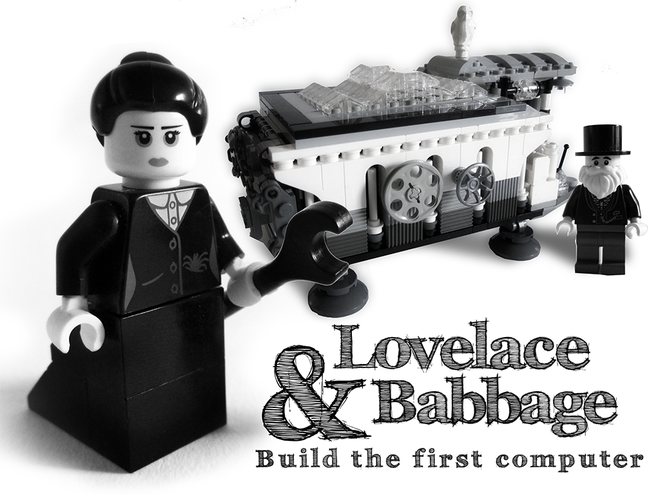
LEGO has a crowdsourcing ideas site, where LEGO fans can pitch ideas for new LEGO sets. What a great way to let your audience help you conduct market research!
Hugh McGuire was kind enough to send me a note about a Lovelace & Babbage set that Stewart Lamb Cromar has proposed. The set would include LEGO figurines for Ada Lovelace and Charles Babbage, LEGO pieces to build a representation of the Analytical Engine, punch cards, and related pieces. The various pieces would be styled with “a steampunk aesthetic” to capture the imaginations of young builders. The set would thus let young LEGO builders realize Babbage’s vision by completing his Analytical Engine, and learn about the historical roles played by Babbage and Lovelace.
(For those who have forgotten their early computing history: back in 1837, Charles Babbage designed a general-purpose (i.e., programmable with punch cards) mechanical computer he called the Analytical Engine. Although a working Analytical Engine was never built, Ada [the Countess of] Lovelace understood the design’s potential and corresponded with Babbage about it. She developed a detailed algorithm for using the Analytical Engine to compute Bernoulli numbers, for which she has been dubbed the first computer programmer. In honor of her contributions, the Ada programming language was named after her. Those interested in more details should read “Lovelace, Babbage, and the creation of the 1843 ‘notes’“, by Fuegi and Francis.)
For what it’s worth, many stories from the “steampunk” genre take place in alternative universes where Babbage actually built an Analytical Engine powered by steam and Ada wrote programs for it. Such stories generally explore the question, “What if … the power of computing was unleashed in the Victorian era?”
 Back in our universe, the dimensions of the LEGO Analytical Engine would be sufficient to accomodate a Raspberry Pi 2, if one wishes to put a computer inside. That would be fun to see: a LEGO Analytical Engine driving an LCD display, mouse, and keyboard!
Back in our universe, the dimensions of the LEGO Analytical Engine would be sufficient to accomodate a Raspberry Pi 2, if one wishes to put a computer inside. That would be fun to see: a LEGO Analytical Engine driving an LCD display, mouse, and keyboard!
One of the motivations for the set is to commemorate the 200th anniversary of Ada’s birth (Dec. 10, 1815). The set would thus teach young LEGO builders some early computing history, and that women have been involved in computing since its origins. It would thus help to counter the popular misperception that only men belong in computer science.
If an idea on the LEGO site receives 10,000 supporting votes, they will consider building the set. To support a project, you must register on their site, but registration only takes a minute, so if you want to raise awareness of computer science in our society, and help young boys and girls realize that computer science is not limited to males, I encourage you to support this proposal by clicking the blue button on the proposal page.



Join the Discussion (0)
Become a Member or Sign In to Post a Comment